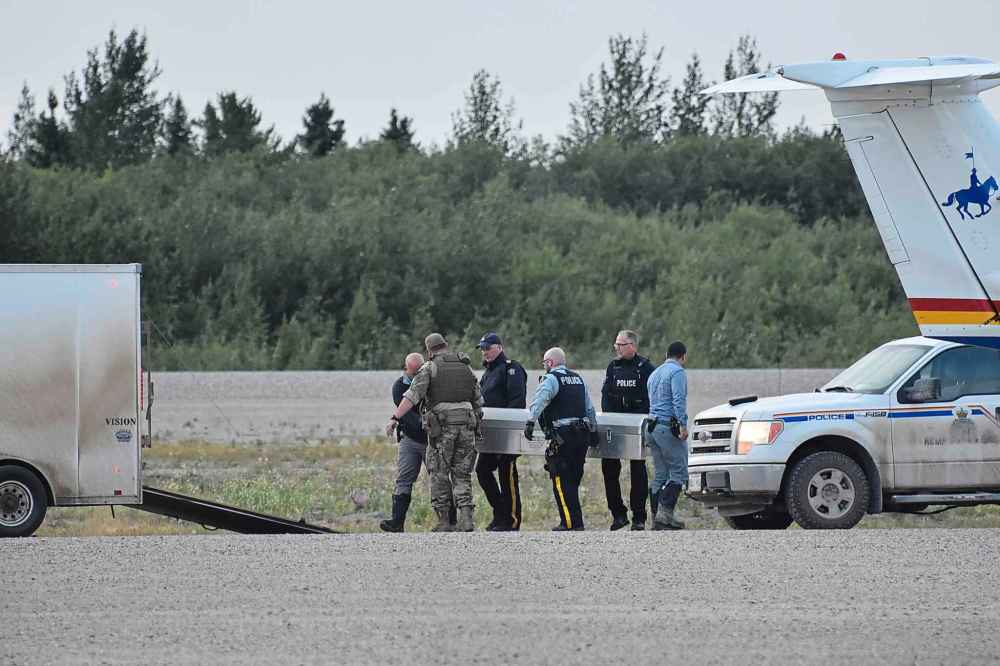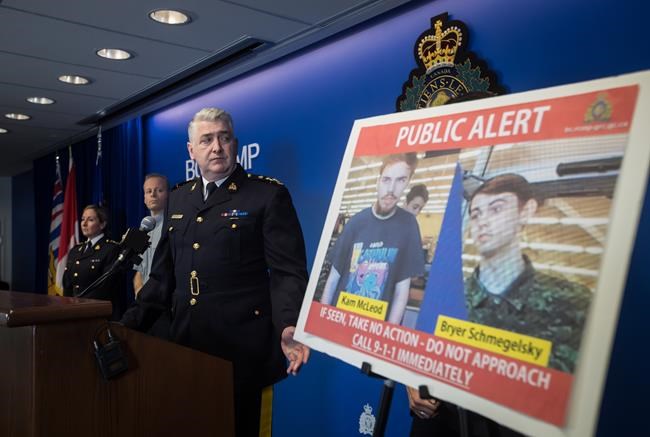Year in Review 2019: Manhunt gripped the nation
Free Press readers say 16-day search for young killers the top Canadian story of 2019
Advertisement
Read this article for free:
or
Already have an account? Log in here »
To continue reading, please subscribe:
Monthly Digital Subscription
$0 for the first 4 weeks*
- Enjoy unlimited reading on winnipegfreepress.com
- Read the E-Edition, our digital replica newspaper
- Access News Break, our award-winning app
- Play interactive puzzles
*No charge for 4 weeks then price increases to the regular rate of $19.00 plus GST every four weeks. Offer available to new and qualified returning subscribers only. Cancel any time.
Monthly Digital Subscription
$4.75/week*
- Enjoy unlimited reading on winnipegfreepress.com
- Read the E-Edition, our digital replica newspaper
- Access News Break, our award-winning app
- Play interactive puzzles
*Billed as $19 plus GST every four weeks. Cancel any time.
To continue reading, please subscribe:
Add Free Press access to your Brandon Sun subscription for only an additional
$1 for the first 4 weeks*
*Your next subscription payment will increase by $1.00 and you will be charged $16.99 plus GST for four weeks. After four weeks, your payment will increase to $23.99 plus GST every four weeks.
Read unlimited articles for free today:
or
Already have an account? Log in here »
Hey there, time traveller!
This article was published 27/12/2019 (2175 days ago), so information in it may no longer be current.
It’s a story that, before anything else can be said, must begin the same way the events did: with three lights being snuffed out on the quiet roads that wind through the crested green of British Columbia’s northern reaches. Amidst everything that came after, the memory of those lights too often faded into the margins.
There was Australian Lucas Fowler, a fun-loving 23-year-old traveller determined to find what adventure the world could hold. His American girlfriend, 24-year-old Chynna Deese, a kind soul who’d come to northern B.C. to join him for a road trip across Canada. They were the first to die, sometime after 3:20 p.m. on July 14.
And there was a gentle Vancouver botanist, Leonard Dyck, who studied seaweed and cherished his two sons and loved the outdoors. His body was found on July 19, more than 470 kilometres southwest of the first two, and a couple of kilometres down the road from a burned-out pickup truck that had been driven by two men, now missing.

These discoveries would kick off a 16-day manhunt for the suspects, childhood friends Kam McLeod and Bryer Schmegelsky, that shook the nation. It is a search that flew across the mountains and Prairies and then up into Manitoba’s northern Cree territories, combed by RCMP and Canadian Forces soldiers.
It’s a search that spread out with a sharp, silent fear. A search that ultimately ended with more questions than answers. And it is that tense, unnerving chase that Free Press readers voted as the year’s top national story.
There were other options for the most gripping Canadian story of 2019. Most of these arguably made a more lasting impact on the nation: the Toronto Raptors surged to a historic NBA title, uniting the country, announcing a new era of Canadian sport. The inquiry into missing and murdered Indigenous women and girls released its damning report.
And federal politics were embattled, first by the SNC-Lavalin scandal, then by the revelations that Prime Minister Justin Trudeau wore racist blackface more times than he could remember. In the end, neither of these concerns proved enough to block the Liberals from claiming a minority government in October’s federal election.
Yet of all these critical stories, the fact that Free Press readers picked the manhunt as the top national headline of 2019 demands further consideration. There was the senselessness of it all: three people murdered, apparently at random. There was the helplessness to contain the fear that the next attack could strike anywhere.
But there was also the way it was covered. Media from across Canada and Australia drove and flew to northern Manitoba to follow the massing police and soldiers, to interview local residents, to try to pry loose any detail that could be reported. There weren’t many: some false sightings and then, later, a battered boat in the water.
That’s the unsettling thing about the manhunt, though; it unfurled, most of all, in our minds. By the time RCMP named Schmegelsky and McLeod as suspects in the three slayings on July 23, kicking off the search, the pair had already made it to Gillam, where their burned-out car was found close to the road into Fox Lake Cree Nation.
What we now know is that, for at least some of the 16-day manhunt that followed, they were already dead. Sightings were reported in York Landing, 200 kilometres south, and in towns and cities across Ontario. None of these sightings were them, it turned out, because they hadn’t gone much farther than the last place they were known to be.
On Aug. 7, their bodies were found in the bush along the Nelson River, about nine kilometres from where their car had been left on the road. They’d died of self-inflicted gunshot wounds. RCMP said there were signs they’d stayed alive for “a few days” after they were last seen, including for some of the manhunt.

Still, the fact that the manhunt outlasted the suspects’ lives meant that it was a haunting, of sorts. In an outburst of wanton cruelty, with a flight into Manitoba’s northern wilds, they spread a pall over the country that remained after they had gone. The fear of those days drew itself from the depths of our minds, and the unknown.
There is something left here to ponder, which is just how easily two young men held the nightmares of a nation captive. Because there are three tragedies here. The first is that three good and innocent people were slain. The second is the impact on the communities of Fox Lake and Gillam, forced to brace against the danger.
The third is how this violent shock could seize the nation’s attention, dominate its headlines and steal the joy from its summer. How abruptly and easily the suspects could gain the notoriety that, one assumes, they wanted, holding our minds captive after they were dead. Even when there was nothing more to see, we couldn’t look away.
We may never have all the answers. In time, perhaps, the memory of the suspects will fade away — and hopefully, leave only the memory of the victims. But for now, those 16 anxious days still loom large in our collective thinking. This is 2019’s top Canadian story, and one whose impact still hasn’t been fully shaken.
melissa.martin@freepress.mb.ca
Our newsroom depends on a growing audience of readers to power our journalism. If you are not a paid reader, please consider becoming a subscriber.
Our newsroom depends on its audience of readers to power our journalism. Thank you for your support.






